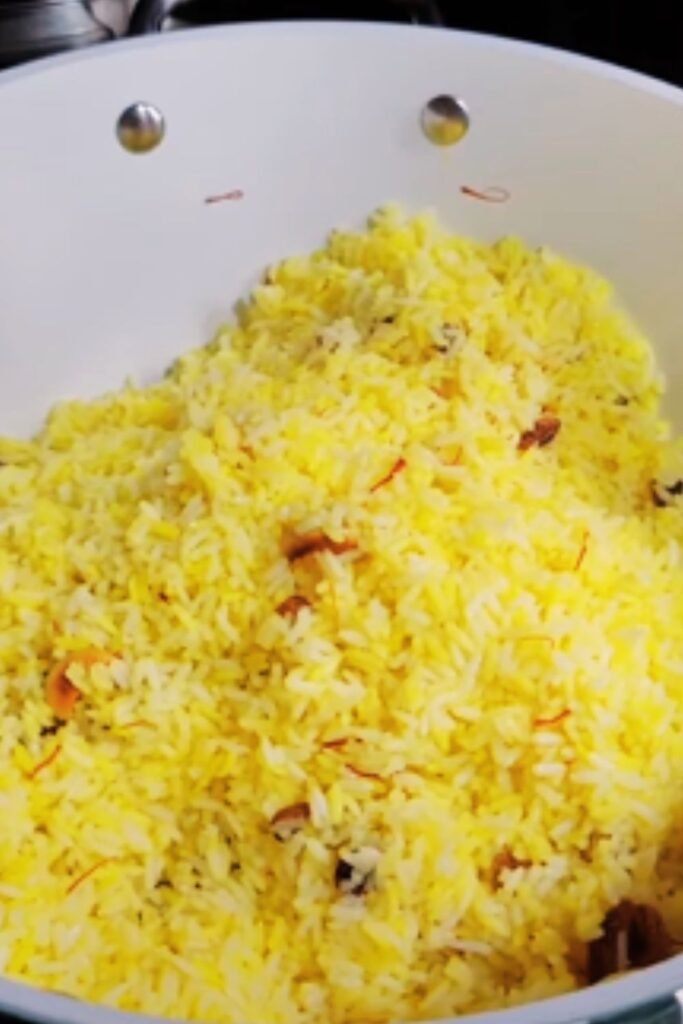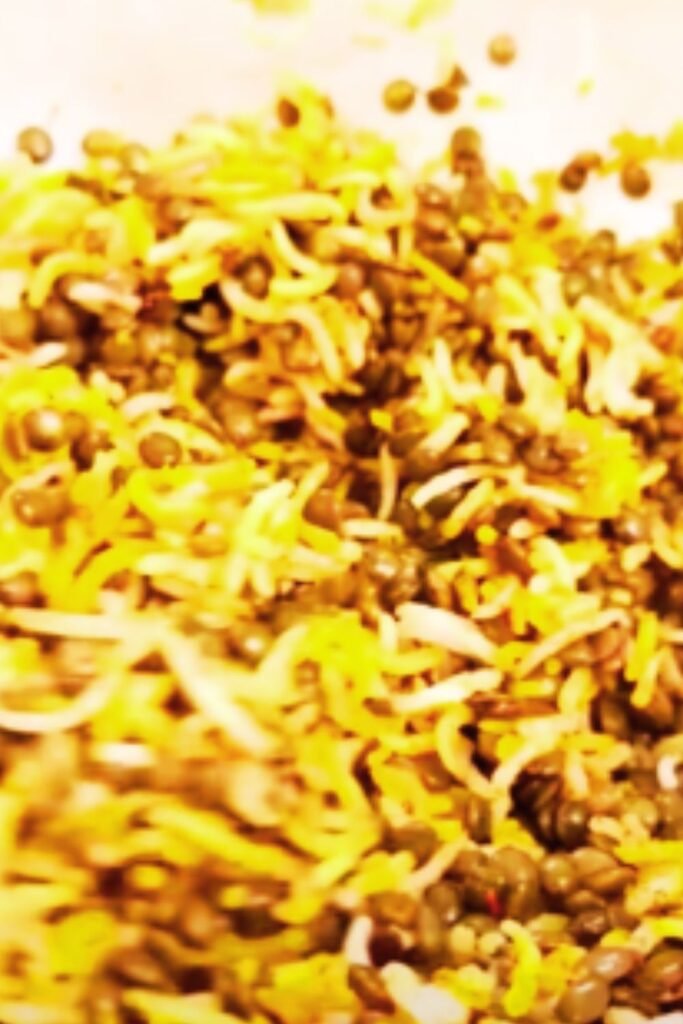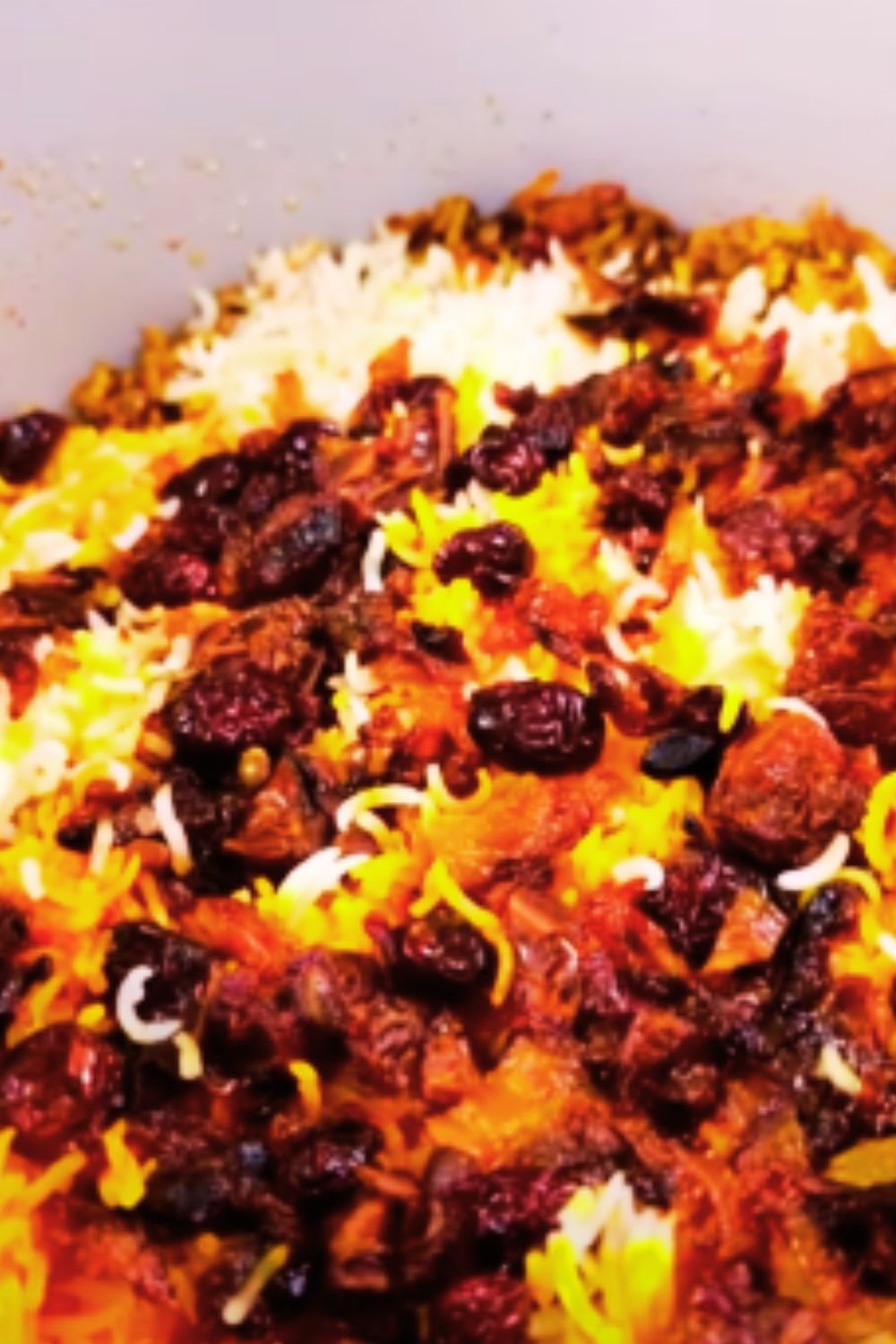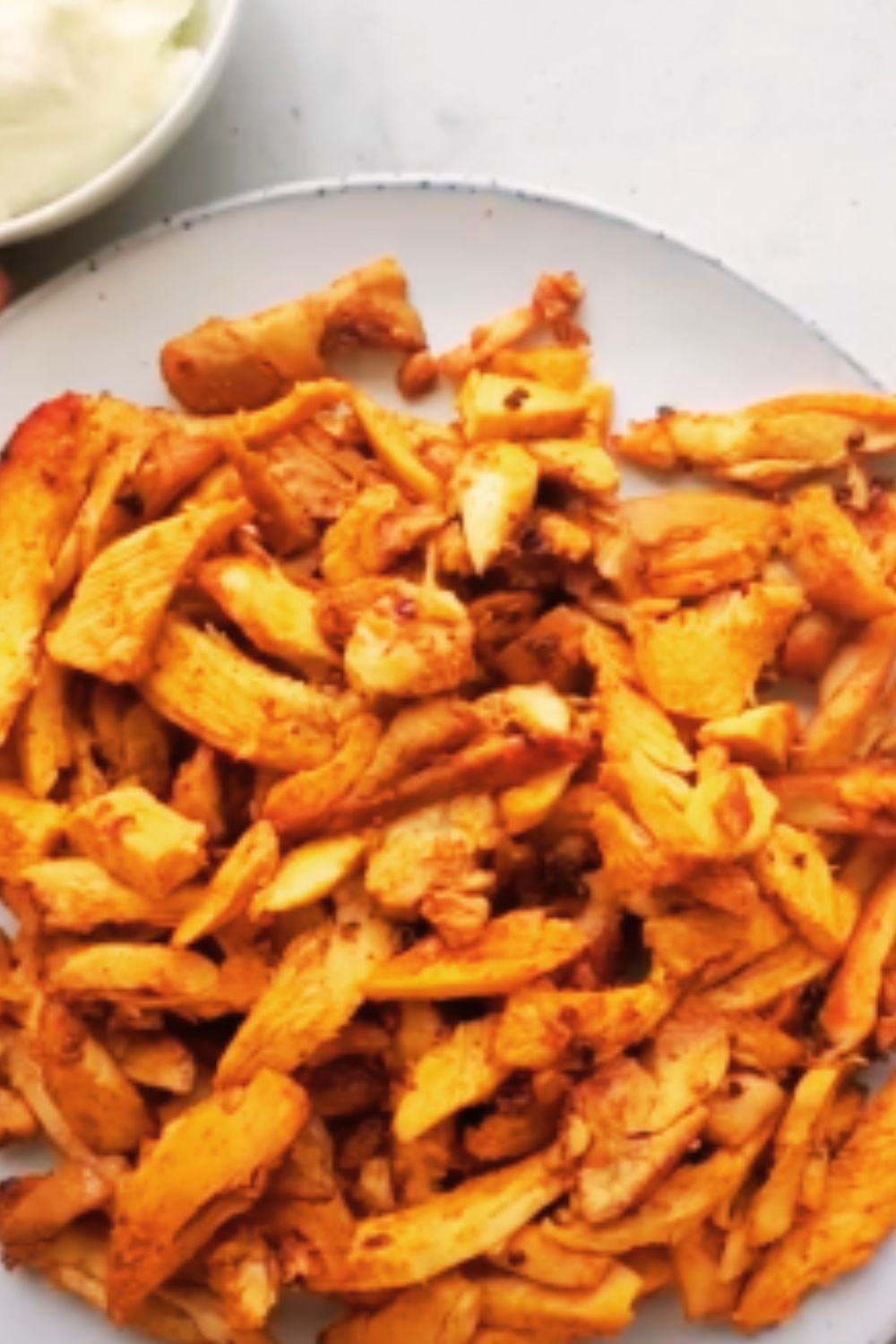There’s something magical about the moment when I lift the lid off a pot of freshly cooked Moroccan saffron rice pilaf. The burst of aromatic steam carrying notes of exotic spices immediately transports me to the bustling souks of Marrakech, where I first fell in love with this golden-hued dish. Today, I’m sharing my simplified one-pot version that delivers all the authentic flavors without requiring hard-to-find ingredients or complicated techniques.
This Moroccan saffron rice pilaf isn’t just delicious—it’s a complete meal that combines fragrant basmati rice with tender vegetables, plump dried fruits, and crunchy nuts. The star of the show is saffron, the world’s most expensive spice, which imparts a distinctive golden color and subtle floral flavor that simply can’t be replicated. Don’t worry though—a little goes a long way, making this luxurious ingredient more accessible than you might think.
Whether you’re looking to expand your culinary horizons or simply want to elevate your weeknight dinner routine, this one-pot wonder delivers maximum flavor with minimal effort. Let me show you how to bring the exotic flavors of Morocco to your dinner table with this foolproof recipe.
The Magic of Moroccan Cuisine
Before diving into the recipe, I think it’s worth taking a moment to appreciate the culinary heritage behind this dish. Moroccan cuisine is renowned for its complex flavor profiles, skillful use of spices, and the harmonious blending of sweet and savory elements—a testament to the country’s rich history as a crossroads of trade routes between Europe, Africa, and the Middle East.
What makes Moroccan cuisine particularly special is how it transforms humble ingredients into extraordinary dishes through the artful combination of spices and slow-cooking techniques. Rice pilaf (or “pilau”) isn’t traditionally Moroccan—couscous is the more common grain—but this fusion dish incorporates all the classic Moroccan flavor principles in a format that’s familiar and comforting to many.
The Star Ingredient: Understanding Saffron
Saffron deserves special attention as it’s central to this dish. Often called “red gold,” saffron consists of the dried stigmas of the Crocus sativus flower. Each flower produces only three stigmas, which must be hand-harvested—explaining why saffron is the world’s most expensive spice by weight.
But what makes saffron truly special is its unique flavor profile:
Flavor: Honey-like, floral, slightly metallic Aroma: Distinctive, hay-like, sweet Color: Vibrant golden-yellow (a natural food coloring)
When buying saffron, here’s what I’ve learned to look for:
Deep red color: Avoid saffron with yellow or orange parts Aroma: Good saffron has a strong, distinctive smell Form: Threads are better than powder (less likely to be adulterated) Origin: Spanish, Iranian, and Kashmiri saffron are renowned for quality Price: If it seems too cheap, it probably isn’t pure saffron
For this recipe, you’ll need just a pinch (about 20-30 threads), which allows you to enjoy this luxury ingredient without breaking the bank.

Essential Equipment
One of the beauties of this recipe is its simplicity in terms of equipment. Here’s what you’ll need:
- Heavy-bottomed pot with lid: A Dutch oven is ideal, but any heavy pot that retains heat well works
- Measuring cups and spoons: For accurate measurements of rice and spices
- Sharp knife: For chopping vegetables and herbs
- Small bowl: For blooming the saffron
- Wooden spoon: For stirring without breaking the rice
Ingredients Breakdown
Now, let’s talk about the ingredients that make this dish special. I’ve broken them down by category to help you understand the role each plays:
The Base
- Basmati rice: 2 cups (the long, aromatic grains are traditional and stay fluffy)
- Olive oil: 3 tablespoons (for sautéing and adding richness)
- Onion: 1 large, finely diced (provides the aromatic foundation)
- Garlic: 4 cloves, minced (adds depth of flavor)
- Vegetable or chicken broth: 4 cups (the cooking liquid that infuses the rice with flavor)
The Spice Blend
- Saffron threads: 1/2 teaspoon (the star ingredient)
- Ground cumin: 1 teaspoon (earthy, warm notes)
- Ground coriander: 1 teaspoon (citrusy, floral complement to cumin)
- Ground cinnamon: 1/2 teaspoon (sweet warmth)
- Turmeric: 1/2 teaspoon (earthy flavor and enhances the golden color)
- Cayenne pepper: 1/4 teaspoon (adds subtle heat, adjustable to taste)
- Salt: 1 1/2 teaspoons (enhances all flavors)
- Black pepper: 1/2 teaspoon (adds complexity)
The Vegetables & Add-ins
- Carrots: 2 medium, diced (sweetness and color)
- Bell peppers: 1 red, diced (sweetness and visual appeal)
- Zucchini: 1 medium, diced (adds freshness and nutrition)
- Chickpeas: 1 can (15 oz), drained and rinsed (protein and texture)
- Dried apricots: 1/3 cup, chopped (sweet contrast to savory elements)
- Golden raisins: 1/3 cup (bursts of sweetness throughout)
- Slivered almonds: 1/2 cup, toasted (crunchy texture contrast)
- Fresh herbs: 1/4 cup each of chopped cilantro and mint (bright, fresh finish)
Nutrition Information
For those keeping track of nutritional content, here’s a comprehensive breakdown per serving (based on 6 servings):
| Nutrient | Amount | % Daily Value* |
|---|---|---|
| Calories | 385 kcal | 19% |
| Total Fat | 12g | 15% |
| — Saturated Fat | 1.5g | 8% |
| — Unsaturated Fat | 10g | – |
| Cholesterol | 0mg | 0% |
| Sodium | 620mg | 27% |
| Total Carbohydrate | 61g | 22% |
| — Dietary Fiber | 8g | 29% |
| — Total Sugars | 16g | – |
| Protein | 10g | 20% |
| Vitamin D | 0μg | 0% |
| Calcium | 80mg | 6% |
| Iron | 3.2mg | 18% |
| Potassium | 580mg | 12% |
| Vitamin A | 4500IU | 90% |
| Vitamin C | 45mg | 50% |
| Folate | 120μg | 30% |
*Percent Daily Values are based on a 2,000 calorie diet
Detailed Step-by-Step Instructions
Now let’s dive into the cooking process, broken down into manageable steps:
1. Prepare the Saffron
The first step is crucial for getting the most flavor from your precious saffron threads:
- In a small bowl, add 1/4 cup of hot (not boiling) water
- Add the saffron threads and allow them to steep for at least 15 minutes
- The water will turn a beautiful golden-orange color – this is your “saffron tea”
This process is called “blooming” and it’s essential for releasing saffron’s full flavor and color potential. Skipping this step means you won’t get the full benefit of this expensive spice.
2. Rinse and Soak the Rice
Properly prepared rice is the foundation of a perfect pilaf:
- Place the basmati rice in a fine-mesh strainer
- Rinse under cold water, stirring gently with your fingers, until the water runs clear (about 1-2 minutes)
- Transfer to a bowl and cover with water, allowing it to soak for 15-30 minutes
- Drain well before using
This process removes excess starch, ensuring your cooked rice will have distinct, separate grains rather than becoming sticky or mushy.
3. Sauté the Aromatics
Now we build the flavor base:
- Heat the olive oil in your heavy-bottomed pot over medium heat
- Add the diced onion and cook until translucent and beginning to turn golden (about 5-7 minutes)
- Add the minced garlic and cook for another 30 seconds until fragrant (be careful not to burn it)
Pay attention to the onions – they should become soft and slightly golden, but not brown, which would give a different flavor profile.
4. Toast the Spices and Rice
This step is crucial for developing complex flavors:
- Add all the ground spices (except the saffron): cumin, coriander, cinnamon, turmeric, cayenne, salt, and black pepper
- Stir continuously for 30 seconds until the spices become aromatic
- Add the drained rice and stir for 2-3 minutes until each grain is coated with the spice mixture and smells slightly toasty
This technique, called “blooming the spices,” releases the essential oils in the spices, intensifying their flavors. Toasting the rice creates a protective coating that helps the grains remain separate during cooking.

5. Add Vegetables and Liquid
Now we build the body of the dish:
- Add the diced carrots, bell peppers, and chickpeas (save the zucchini for later as it cooks quickly)
- Pour in the broth and the saffron with its soaking liquid
- Stir gently and bring to a boil
- Once boiling, reduce heat to low, cover the pot tightly, and simmer for 10 minutes
The tight seal is crucial here – it creates a pressurized environment where the rice can absorb the liquid evenly without losing moisture to evaporation.
6. Add Quick-Cooking Ingredients
Some ingredients need less cooking time:
- After the initial 10 minutes, quickly add the zucchini, dried apricots, and golden raisins
- Do not stir! Simply scatter them over the top, replace the lid immediately
- Continue cooking for another 5-8 minutes, or until all liquid is absorbed
The steam in the pot will cook these more delicate ingredients without disturbing the rice below.
7. Rest and Finish
The final step is often overlooked but is crucial for perfect texture:
- When cooking is complete, remove from heat but keep the lid on
- Let the pilaf rest, undisturbed, for 10 minutes
- After resting, fluff the rice gently with a fork, folding in the toasted almonds and fresh herbs
- Taste and adjust seasoning if necessary
This resting period allows moisture to distribute evenly throughout the dish, resulting in perfectly tender rice with distinct grains.
Troubleshooting Common Issues
Even experienced cooks encounter challenges. Here are solutions to common problems:
Rice is Undercooked
- Problem: Rice is hard in the center.
- Solution: Add an additional 1/4 cup of hot broth or water, cover, and cook on low for 5 more minutes. Then rest again.
- Prevention: Ensure your heat source is consistent and your pot has a tight-fitting lid.
Rice is Overcooked
- Problem: Rice is mushy or sticky.
- Solution: Unfortunately, this can’t be fixed completely. Spread the rice on a baking sheet to help excess moisture evaporate.
- Prevention: Be precise with your liquid measurements (1:2 ratio of rice to liquid) and don’t exceed the cooking time.
Saffron Color is Weak
- Problem: The rice lacks that distinctive golden hue.
- Solution: Next time, bloom the saffron longer (30 minutes) in hotter water.
- Prevention: Ensure you’re using good quality, fresh saffron and properly blooming it before adding.
Flavors Seem Flat
- Problem: The dish lacks vibrancy.
- Solution: Add a squeeze of fresh lemon juice and extra fresh herbs before serving.
- Prevention: Toast spices adequately and use fresh spices (replace ground spices every 6 months).
Serving Suggestions
This pilaf can stand alone as a vegetarian main dish, but it also pairs beautifully with:
- Proteins: Grilled lamb chops, roasted chicken, or seared fish
- Sauces: Yogurt sauce with cucumber and mint, or harissa for heat
- Vegetables: A simple salad of cucumber, tomato, and red onion dressed with lemon juice and olive oil
- Bread: Warm flatbreads like naan or pita for scooping
For a complete Moroccan-inspired feast, serve alongside:
- Moroccan carrot salad with cumin and cilantro
- Spiced olives
- Roasted eggplant dip
- Fresh mint tea in small glasses
Storage and Reheating Tips
One of the beauties of this dish is that it often tastes even better the next day. Here’s how to store and reheat properly:
Storage
- Refrigeration: Cool completely, then store in airtight containers for up to 4 days.
- Freezing: Portion into freezer-safe containers and freeze for up to 3 months.
Reheating
- Microwave: Sprinkle with a few drops of water, cover loosely, and heat in 30-second intervals, stirring between.
- Stovetop: Place in a pan with 1-2 tablespoons of water, cover, and heat gently, stirring occasionally.
- Oven: Place in an oven-safe dish, cover with foil, and heat at 350°F (175°C) for 15-20 minutes.
Revitalizing Leftovers
To make leftover pilaf taste freshly made:
- Add a drizzle of good olive oil
- Sprinkle with fresh herbs
- Add a squeeze of lemon juice
- Consider adding a new texture element like pomegranate seeds or additional toasted nuts
Customization Options
One of the things I love about this recipe is its flexibility. Here are some ways to adapt it to your preferences or what you have on hand:
Dietary Adaptations
- Gluten-Free: Already gluten-free!
- Vegan: Use vegetable broth instead of chicken broth (if using)
- Low-Carb: Substitute cauliflower rice for half of the basmati rice
- Higher Protein: Add extra chickpeas or toasted pine nuts
Seasonal Variations
- Spring: Add fresh peas and asparagus tips
- Summer: Incorporate diced summer squash and fresh corn kernels
- Fall: Include cubed butternut squash and dried cranberries
- Winter: Add roasted root vegetables like parsnips and turnips
Regional Twists
- Persian Influence: Add a pinch of ground cardamom and swap apricots for barberries
- Indian Variation: Add mustard seeds, curry leaves, and swap chickpeas for paneer
- Mediterranean Adaptation: Include sun-dried tomatoes, olives, and feta cheese
- North African Twist: Add preserved lemon and swap almonds for pistachios

Detailed Ingredient Sourcing Guide
For those who want to elevate this dish to the next level, let me share some tips on sourcing the best ingredients:
Sourcing Saffron
As the most expensive spice in the world, saffron deserves special attention:
- Spanish Saffron (Mancha): Known for its rounded flavor and aroma
- Iranian Saffron (Sargol): Often considered the world’s finest, with a more intense color
- Kashmiri Saffron: Darker in color with strong aromatic properties
- Avoid: Powdered saffron (often adulterated) and anything suspiciously inexpensive
Look for saffron at specialty grocers, online spice merchants, or international markets. Expect to pay $5-15 for a small quantity (enough for several recipes).
Rice Selection
While any basmati rice will work, these options produce exceptional results:
- Aged Basmati: Develops more flavor and aroma during cooking
- Texmati: An American-grown basmati variety with excellent texture
- Tilda or Daawat brands: Consistently high quality
Spice Quality
For spices that truly shine:
- Buy whole when possible: Grind cumin and coriander seeds yourself
- Purchase from spice specialists: Higher turnover means fresher stock
- Store properly: In airtight containers away from heat and light
The Cultural Significance of Rice Pilaf
While preparing this dish, I like to remember its rich heritage. Rice pilaf (or “pilau”) has been a staple across the Middle East, Central Asia, and North Africa for centuries. The term derives from the Persian “polow,” and variations exist from India (pulao) to Turkey (pilav) to Spain (paella).
In Moroccan culture specifically, communal meals are central to social life. Traditionally, elaborate dishes are served in the center of the table, with family and guests gathered around. While couscous is more traditional in Morocco, this saffron rice pilaf adapts Moroccan flavors to the rice preparation methods common throughout the broader region.
The inclusion of fruits and nuts in savory dishes is characteristic of festive Moroccan cuisine, reflecting the influence of Persian culinary traditions that traveled the ancient Silk Road. The contrast of sweet and savory elements symbolizes the balance and abundance desired in life.
FAQ: Your Questions Answered
Here are answers to some common questions about making Moroccan saffron rice pilaf:
Q: Can I use regular long-grain rice instead of basmati?
A: Yes, but the texture and aroma will be different. If using regular long-grain rice, reduce the liquid by about 1/4 cup and adjust the cooking time according to package directions. Basmati really does provide the best flavor and texture for this dish.
Q: Is there a substitute for saffron?
A: Unfortunately, nothing truly replaces saffron’s unique flavor. Turmeric can provide the golden color, but not the flavor. If cost is a concern, use just a few threads of saffron and supplement with 1/4 teaspoon extra turmeric.
Q: How can I make this into a complete one-pot meal with protein?
A: Add 1 pound of cubed boneless chicken thighs (sauté them after the onions, before adding spices) or 1 pound of peeled, deveined shrimp (add during the last 5 minutes of cooking).
Q: My rice always sticks to the bottom of the pot. What am I doing wrong?
A: This could be due to too high heat or a pot that doesn’t distribute heat well. Use a heavy-bottomed pot, ensure your heat is low during simmering, and make sure you’re toasting the rice properly before adding liquid.
Q: Can I prepare this dish in advance for a dinner party?
A: Yes! You can prepare it up to 2 days ahead. Reheat covered in a 325°F (165°C) oven with 2-3 tablespoons of water sprinkled over the top until heated through (about 25 minutes). Add the fresh herbs just before serving.
Q: My dried fruit always clumps together. How can I prevent this?
A: Toss dried fruits with a teaspoon of the spice mix or a light dusting of flour before adding them to the pot. Also, make sure you’re adding them on top without stirring initially.
Q: Is this dish spicy hot?
A: As written, it has a mild warmth from the cayenne. For a child-friendly version, omit the cayenne completely. For more heat, increase the cayenne to 1/2 teaspoon or add a minced jalapeño with the vegetables.
Q: How can I tell when the rice is done without lifting the lid?
A: Listen for the sizzling sound to stop (indicating the water has been absorbed) and pay attention to the aroma—you’ll smell a nutty, cooked rice fragrance when it’s nearly done. If you must peek, do so very quickly.
A Personal Note
I first encountered a version of this dish while traveling through Morocco years ago. I was staying with a family in a small town outside Fes, and the grandmother of the house prepared a similar rice dish for dinner one evening. What struck me was not just the incredible flavors, but how she transformed humble ingredients into something truly spectacular through careful technique and the judicious use of spices.
When I asked for the recipe, she laughed and said there wasn’t one—just years of experience and an understanding of how flavors work together. It took me several years of experimentation to recreate something that captured the essence of that meal, and this recipe is the result.
What I love most about this dish is how it brings a sense of occasion to an ordinary weeknight dinner, yet is simple enough that anyone can master it. The gorgeous golden color, the intoxicating aroma, and the complex layering of flavors make it feel special, while the one-pot preparation keeps it practical.
I hope this recipe brings a touch of Moroccan magic to your table, just as it has to mine over the years. Food has this wonderful ability to transport us to far-off places, even when travel isn’t possible. Consider this pilaf your culinary passport to Morocco—no plane ticket required.
Happy cooking!


